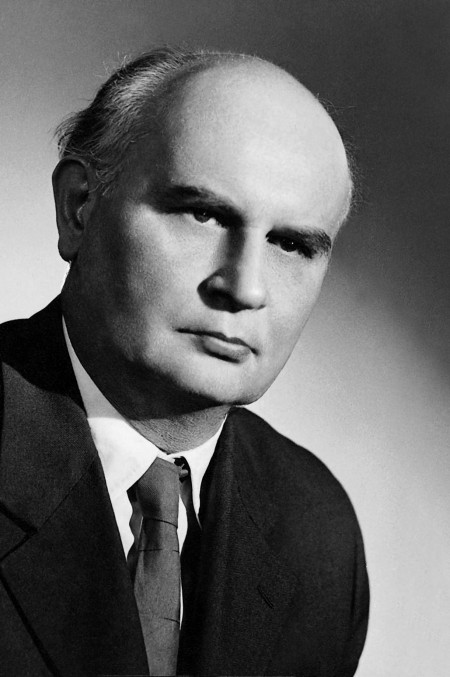27 December 1911, Kistétény – 25 June 1977, Budapest
As one of the most significant figures of the composer generation following Bartók and Kodály, he was connected to the Academy of Music for forty out of the altogether sixty-five years of his life: two times five years of study and almost three decades of a career as a teacher tied him to the institution. It is especially significant at his composition-teacher career that his students could respect such a master in his person who was an outstanding composer at once, furthermore, according to many, the most talented among his generation; who, suffering from the changes of his controversial era has never evaded from the challenges of his creative conscience. This consistent, ethical and self-critical behavior explains that the artistic path of Szervánszky was made difficult by dramatic turns and deep crises, however probably those made him a wise and understanding master, who not only introduced his students to technical elements of composition, but also provided them with viaticum for a lifetime through his exemplary personality.
Endre Szervánszky was born in 1911 in Kistétény. His father was a military officer but characteristic of the family's love for music is that further three of his brothers became musicians. Szervánszky studied clarinet performance at the Academy of Music between 1922 and 1927. He remained faithful to his chosen instrument as a composer, as well: his intimate relation to the clarinet is expressed at his most serene works, the Clarinet Serenade (1950) and the Clarinet Concerto (1965). He pursued his composition studies with Albert Siklós between 1931 and 1936. He finished his First String Quartet in 1938, the premiere of which brought the first great compositional success for him in 1943. The quartet shows a powerful influence of Bartók and the Bartókian inspiration remained crucial for Szervánszky later on as well. Besides his work as a composer he had been teaching continuously from the end of the 1930s: at first music theory in music schools then score reading and composition at the Nemzeti Zenede [Music Secondary School]. During the years of the war – together with the intellectual elite of his era – he was opposed to the reigning governing system and proceeded to active political resistance: he was a member of left-wing intellectual and artistic groups at the beginning of the 1940s, and pursued human-rescuing activity during the German occupation. He was music critic of the newspaper Szabad Nép between 1945 and 1949. His honest belief in the ideology of the Party is reflected in his works: the Serenade for Strings from 1947, or the above mentioned Clarinet Serenade radiate the mandatory serenity of the "socialist realism" in which there are no traces of the avant-garde boldness of the young Szervánszky. However his pieces within this limited style built on a false ideology belong to the most valuable works of the Hungarian repertoire of that era. It is not accidental that György Kurtág considered the Serenade for Strings as valuable as he made one portion of it (the unfinished quotation of the theme of the slow Arioso movement) the poetic closing momentum of his 28th opus. Szervánszky who was successful at the fashionable genres of the era such as the folksong-cantata (Honvédkantáta) and the concerto (Flute Concerto) became professor of the Academy of Music in 1948. He was awarded the Kossuth-prize in 1951 and in 1955. Although the optimistic serenade-voice darkened finally, as the composer realized the real nature of the communist rule: his Concerto In the Memory of József Attila composed in 1955 divined the approaching historical storm. Szervánszky was the first in the Hungarian post-War composition who reached to the depths of the most expressive Bartók-style. "This lonely midnight voice of Bartók and the death-music of the Mandarin are continued here first by the music of the successors." – writes György Kroó referring to the József Attila Concerto and the String Quartet No. 2 1956/1957. Szervánszky also undertook the unpleasant task of pioneering when he opened space for twelve-tone construction at the Hungarian composition which was locked from the European development, and "entered the gate of the realm of avant-garde effects and colours" with his Six Orchestral Pieces. The work composed in 1959 caused great sensation at its premiere, one year later. "This composition hit the first gap on the gate of the old style, which can not be filled" and made immeasurable liberating impact on the younger composer generations. Szervánszky did not appear with new composition for a long time and at his late works mostly the transparent colours of the Clarinet Concerto (1965) and the clear spirituality of the Three Holy Songs (1972) imply the newly found harmony.
The composition teaching of Szervánszky almost counterpointed the educational method of his colleague of great impact, Ferenc Farkas. While Farkas emphasized the careful instruction of all the elements of craftsmanship and the numerous technical tricks of the manual work, Szervánszky raised the awareness of his students for the responsibility of the artist and instead of practicing the virtuosic cultivation of the profession, he kept in mind the unbidden internal maturation. It is not accidental that many of his students have not become professional composers, although such composers grew out of his workshop as János Decsényi, József Sári, Sándor Balassa, László Sáry, Iván Madarász, Lajos Huszár and Zsolt Serei.
F. Z.



